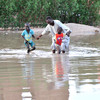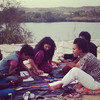South Sudan’s women in the spotlight [part 4]
A legion of brave women is working
In South Sudan, women shoulder most of the responsibility for the well being of their families. As a result, women were particularly affected by the decline of service delivery during the country’s second civil war. Women played important roles in keeping some of these services going during this time, taking over where services were failing -- sometimes because the men who were providing them had to go off to war.
Other resources that focus on gender in South Sudan:
Small Arms Survey’s Human Security Baseline Assessment for Sudan and South Sudan
UNICEF in South Sudan
United States Institute for Peace
Women for Women in South Sudan
UNDP in South SudanWhen the civil war officially ended with the Comprehensive Peace Agreement (CPA) in 2005, South Sudan’s new leadership promised to restore health, education and civil services. A flurry of activity, investment and development began in the years that followed, but a shortage of personnel, infrastructure and funding have significantly limited these efforts.
Today, South Sudan continues to be ranked near the bottom of the Human Development Index (UNDP, 2010). The majority of people in the country are unable to read and write. The country’s health sector is poorly placed to deal with the major challenges it faces, which include high infant, child and maternal mortality levels and a range of diseases, viruses and conditions. Health departments and ministries are only just getting established. No health services are available across large areas of the country.
It is in this context, that a legion of brave women is working to make education and adequate health care accessible to as many people as possible.
The women who guard the health of a nation
Women in the health sector work long and hard hours, and are paid extremely low salaries for their efforts. Often, over and above the stresses of work, they have to worry about making ends meet. Grace Adiye, a nurse in the town of Nimule, begins her working day with a three-kilometre walk to the local health clinic where she works. Besides taking care of herself and her young children, she sends some of her salary to her mother and some to pay the school fees of her siblings.
Sometimes when there is an emergency that we have to work on at the hospital, I am paid a bonus. Then I can afford two meals. Otherwise, I only have one meal each day, so that I do not use all my money before the end of the month.”
Frequent delays in the payment of salaries cause immense hardships to women who need to work as carefully with their money as Grace.
In the years since the war ended, the brain-drain continues to hamper the provision of health services, and it operates at all levels of the health sector. With staff shortages in health facilities compounded by a lack of equipment and supplies, illnesses, wounds, disease and pain often go untreated as the hospitals wait for the delivery of medications and supplies.
Raida Jokudu, a senior nurse at Mundari hospital, explains: Sometimes the doctor recommends that a patient should undergo a blood transfusion. Since we do not have a blood bank in Mundari hospital we advise the patients to find a donor, and then we can carry out the necessary tests. Sometimes, by the time we find a donor with a matching blood type, it is too late to save the patient.”
In these dire working conditions, frustration and low morale is common, and the quality of services provided is often poor. Despite this, many of the women of South Sudan’s health sector are extremely committed to their work and many of those interviewed expressed the hope that their conditions will soon improve, that there will be more clinics, medicines, personnel and equipment, so that they can experience more joy and success in caring for the health of their war-worn people.
While it is unlikely that quality health-care services will soon be available to all throughout the country, indications are that the health-care sector is moving in the right direction.
Education
Like health, education services are in a worrying state. Decades of civil war denied entire generations of South Sudanese access to even the most basic education. There is a severe shortage of teachers, and the great majority of teachers have no qualifications or teacher training.
Watch the documentary film A SCHOOL DAY WITH DIANA, reflecting one day in the life of a 13-year-old South Sudanese schoolgirl, which stands exemplary for many other girls in the region.Besides lacking teachers, schools around the country lack infrastructure, equipment and teaching resources. Many schools don’t have buildings, and classes are held in the shade of trees.
Even if the children come to school, when it starts raining, I cannot teach because the only place to teach them is under the tree. I try as much as possible to cover the syllabus during the dry season, but then I cannot teach everything because I cannot push the children beyond their capacity, ” says Assunta Gaba from Eastern Equitoria.
South Sudan’s teachers work hard, in overcrowded classes, often struggling to juggle their personal and professional responsibilities. For teachers who are also mothers, as most of the female teachers are, the challenges can be daunting.
Promising signs
Also read:
‘We were all soldiers’: Female combatants in South Sudan’s civil war [part 1]
‘Sibu ana, sibu ana’: Survivors of sexual violence in South Sudan [part 2]
‘If you can’t use your hands to make a living…’: Female sex workers in Juba, South Sudan [part 3]There is a significant shortage of staff in the South Sudanese civil service. However, in the women of South Sudan, the country has a great, untapped resource, which if adequately trained, could contribute to reducing the drastic shortfall in human resources. In terms of health and education, despite the severe challenges in these sectors, there are some promising signs.
The first (ever) College for Nursing and Midwifery has been established in the capital, Juba, and has enrolled its first students in an intensive, accredited three-year diploma course. Of the first student intake, two-thirds are female. In addition, the Ministry of education’s Directorate of Gender and Social Change is providing scholarships to over 8,000 female students to enable them to complete their secondary education and join the teaching profession. After finishing their secondary education, these students are recruited directly into teacher-training institutes.
Download the bibliography:
Taking on new challenges: Women in Service DeliveryAll the women interviewed take pride in their work, and take their responsibilities seriously. Faced with daily challenges, women are nevertheless continuing to contribute to the rebuilding of their country, balancing this with their many other responsibilities as wives and mothers.
Adapted by Cara Meintjes, from Jane Namadi’s chapter, Taking on new challenges: Women in Service Delivery” in Hope, Pain and Patience: The Lives of Women in South Sudan. Edited by Friederike Bubenzer and Orly Stern. Photographs by Irene Abdou and Jenn Warren. A Publication of the Institute for Justice and Reconciliation. ISBN Number: 978-1-920196-36-3. Published by Jacana Media. Available from http://www.jacana.co.za/





